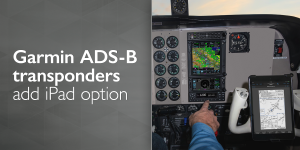
Many pilots may be wondering how there can possibly be another ADS-B product, what with a slew of options from Garmin, L-3, Aspen, Appareo, Avidyne and Freeflight already out there. Isn’t the market full? It’s certainly crowded, but Garmin’s introduction this week of a new series of 1090 MHz ADS-B Out transponders is noteworthy for a few reasons.
First, it fills a gap in Garmin’s ADS-B lineup, which has been heavy on 978 MHz options (like the GDL 88 and GDL 84) but light on the more popular 1090ES option – which accounts for over 75% of the ADS-B installs to date. Secondly, it finally offers an upgrade path for all the G1000 glass cockpit airplanes who have been unable to upgrade to ADS-B efficiently. Finally, the new products extend Garmin’s push into the connected cockpit world, by integrating panel avionics with tablets and portable GPSs.
Garmin’s announcement consists of two main products, the GTX 335 and the GTX 345. The 335 is an ADS-B Out only product (meaning no weather or traffic reception via ADS-B In), but it offers an affordable, easy-to-install package that will be particularly attractive for older airplanes in need of a new transponder. It is available with a built-in WAAS GPS for $3795 or without a GPS for $2995.
The GTX 345 is a deluxe ADS-B solution, including 1090ES ADS-B Out as well as dual band ADS-B In. The subscription-free weather and traffic received over ADS-B In can be displayed on your iPad (Garmin Pilot or ForeFlight apps), Android (Garmin Pilot app) or portable GPS (aera 796/795). It includes a FlightStream to make the wireless link from panel to portable. The GTX 345 is available with a built-in WAAS GPS for $5795 or without a GPS for $4995.
Perhaps the biggest news is for G1000-equipped aircraft: remote versions of each box (GTX 335R and 345R) are available, and will be approved for installation on a number of models. The list includes the Cessna 172/182/206, Diamond DA-40/42, Beech Bonanza and Baron, Piper PA-28/34/44/46, and Mooney M20TN/M20R/M20M. Most of these airplanes haven’t had a good option for ADS-B Out until now.
How is an aircraft owner supposed to choose from all the options? We would consider three steps:
- Choose whether the 1090ES or 978 UAT option makes sense. 978 is usually less expensive on the hardware side, but more expensive on the installation cost since it is a remote box. 978 may only be used in the US and below 18,000 ft, so it isn’t a good option for pressurized or turbocharged airplanes. If your current Mode C transponder is in good shape, though, a 978 upgrade may make sense.
- Next, decide whether you need a WAAS GPS. This is required to meet the FAA’s mandate, but if you already have a GNS 530W or GTN 750, you do NOT need to buy another GPS (hence Garmin’s options here both with and without GPS).
- Finally, consider whether and how you want to get ADS-B In. This feature allows you to receive subscription-free weather and traffic, which is a great aid to situational awareness. If you do want ADS-B In, you can receive it with a portable unit (like the Stratus 2S or GDL 39) or with panel-mounted avionics like the GTX 345.
While the ADS-B mandate may not be pilots’ favorite FAA rule, and the options may be confusing, it’s safe to say that any aircraft owner considering an upgrade now has a wide market to choose from. Whether you fly an old 152 or a new TBM, there is an option for almost any airplane. Get educated, talk to your avionics shop and make plans to upgrade.
Source: Ipad appsNew ADS-B transponders from Garmin include iPad option

